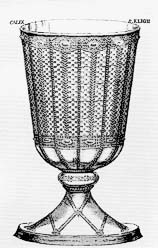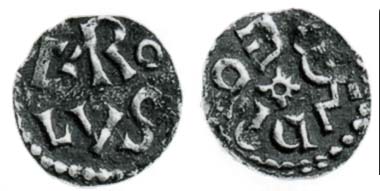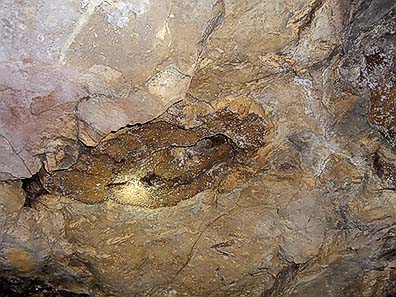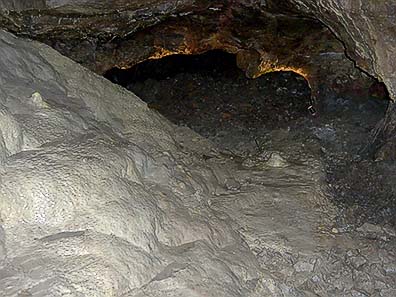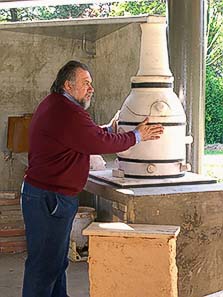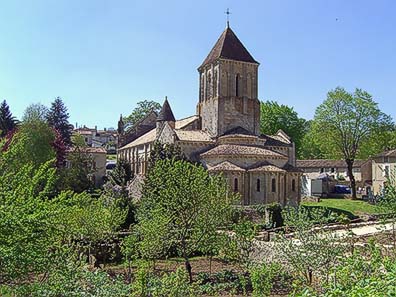When the Arabs went out in the 7th century to conquer a vast empire with their new faith, the world changed not only religiously and politically but also economically. So far, backward Western and Central Europe had received their gold from the Byzantine Empire, but under those circumstances they ran short of supplies. The Merovingian mint masters were left stranded. The coin production of the Franks, which hitherto had already been done on a small scale, was threatened to come to a halt altogether unless no way out was found.
Saint Eligius, a pioneer of technology?
It is perhaps this economic crisis the mint master Eligius owed his canonization to. Ian Blanchard, author of a comprehensive three-volume study on mining, metallurgy and coining in the Middle Ages, points to the fact that under Eligius, for the first time in a long while, in the Royal mints at Marseille and Arles a big proportion of silver was added to the alloy which the planchets were made of afterwards.
Fig. 1: Chalice of Eligius, after a copperplate print of 1793. The work made by Eligius was preserved in the Chelles Monastery until the French Revolution when it was melted down.
Eligius was born in 588 in the small town of Chaptelat, not far from Limoges. He was taught by the widely known goldsmith Abbo who also was Royal mint master. Limoges was an important commercial town in those days. Blanchard postulates that Eligius made himself familiar there with a new technique that was already successfully applied in the Byzantine Empire and in the South of France. In Central and Northern France, where only such methods were used that were already known in Antiquity, a mine could only be run economically when the material contained between 12.5 and 95 ounces silver per ton, i.e. between 356 grams and 2.693 kilograms per ton. Thanks to the new procedure of enrichment, which made use of the fact that lead has a lower melting point than silver, the old Roman mines that had been exploited already in Ancient times could be reopened to mine those strata of rock which contained less silver. Eligius may have known this method. It is perhaps thanks to that knowledge and not – as the Life of Saint Eligius tells us – to the golden throne with gem stones he has made for Chlotar II that he was granted the privileged position of Royal mint master. In 625, Eligius was entrusted with the management of the mints of Marseille, Arles and Paris. As mentioned above, in Marseille and Arles silver was used on a large scale as coin metal again for the first time after a long while.
Melle, the ancient Metulum
One of the mines that supplied the silver for the coins was Melle, ancient Metulum, whose name is closely connected with the Latin word for mine, “metallum”. A huge deposit of galena was located here whose exploitation with the old methods was not profitable. As a matter of fact, we do not know of any mining activity in the Roman era whatsoever.
The new technique, on the other hand, made the exploitation of Melle profitable even though its galena contained only 2 grams silver per kilogram, and no more than 10 grams of galena could be gained from one kilogram of rock. Someday, at the end of the 7th or the beginning of the 8th century, when the entire coining of the Western world changed from gold to silver, the Melle mine opened.
Fig. 2: Charles the Great, 768-814. Denarius from Melle. MEC 728. From auction sale Münzen und Medaillen AG, Basel 81 (1995), 1003.
Melle was the wealth of the Frankish kings. Even the small number of Carolingian coins that have come down to us bear testimony to the importance of this mine through their big ratio of denarii alone.
Worth knowing and thrilling as this may be – what makes Melle unique is that the mines were exploited during the Middle Ages only to the result that the drifts and tunnels are preserved in their original state. Today, they are open to the public and can be viewed in a roundtrip.
Fig. 3: View into an Early Medieval gallery with many tunnels. To ensure that the rock was reasonably supported, big stone pillars were left between the individual drifts.
A visit to Melle
Anyone interested in visiting the Melle mine is guided by numerous signs in the vicinity. The mine is accessed on ground level via a newly built entrance. In the Middle Ages, the miners got through vertical drifts to horizontal galleries where they mined galena from the layers that were up to 6 metres thick. Approximately 300 metres of such a gallery can be comfortably visited today. But this is only a small part of the system of drifts. Since its discovery in the 19th century, scientists have studied roughly 20 kilometres of the subterranean system of drifts and tunnels.
Fig. 4: Geode with rock containing galena.
Until the present day, the traces of the technique with which the layers containing galena were mined are clearly visible. Rounded stone surfaces that almost appear polished are the result of fire. The miners brought wood to the drifts, lighted their fire in close proximity to the rock to be blasted and waited. Due to the heat that could rise up to 300 degrees Celsius, the rock went into thermal shock. The brittle rock split and, after a couple of days after the fire when the toxic fumes had disappeared, the galena containing material could be transported to the surface.
On the environment, however, this procedure was a great strain. As archaeological experiments proved, 1.140 kilograms of wood were needed to blast one cubic metre of rock. One cubic metre equals 802 kilograms. From that amount 8.020 kilograms of galena could be gained which brought 16.04 grams of silver. 1.140 kilograms of wood for an amount of silver necessary to produce roughly 12 Carolingian denarii – the Carolingian kings obviously saw that as good business.
Fig. 5: Behind the dump of overburden, already completely covered by the lime of the seeped water, there is another dump of waste material that was already sorted out in the mine.
The waste material, already sorted out in the mine, is piled in huge heaps. A transport to ground level was too costly. Abandoned drifts were filled and the mined but worthless rocks that were piled almost everywhere can be seen up to the present day. There is not much danger that a visitor might take such a testimony of the Carolingian art of mining with him. After all, any material in the drifts is covered by a thin layer of lime as a result of the water that seeped into the tunnels from the 19th century onward and slowly causes the mines to change into a Romantic stalactite cave.
Silver smelting under the Carolingians
Back from the mines, the surprised visitor discovers a huge experimental field where the scientists of the CNRS, under the supervision of Florian Téreygeol, conduct public experiments on the Carolingian silver smelting.
After all, we know very little about the real conditions under which the silver was extracted from the rock in those days. All we are left with are presumptions based on the knowledge of ancient techniques and the comprehensive work of Georgius Agricola from the 16th century.
Today it is assumed that the first crushing of galena was done underground. During that stage, another, more thorough selection of silver containing rock and waste material could be conducted. Hence, only a small portion of the mined rock was transported to the surface in the end. Another crushing and selection were undertaken over ground. After that, the material, i.e. the rock pulverized to stone-grit, was washed in water basins to separate the heavier stone that contained silver from the lighter waste material.
Fig. 6: Reproduced melting furnace in Melle.
The smelting was done near the washing facilities. The silver containing lead was melted out the rock in huge melting furnaces, after that lead and silver were separated. All this sounds very logical and concise but there is actually very little we know for sure about the working details involved. How did such a melting furnace look like? Which combination of rock and charcoal was most efficient? And how was a charcoal suitable for the burning produced in the first place? Much remains untold, therefore, and the scientists try to go to the bottom of things.
Fig. 7: Lead and silver got separated in the cupellation furnace. The method is based on the fact that lead oxidises at a lower temperature than silver and that, in this state, it attaches to certain materials the furnace is lined with.
Therewith they produce charcoal, cast and smelt and extract the silver from the lead, produce iron and mint coins. Visitors are invited to have a look at the team of scientists at summer weekends.
Melle in the High Middle Ages
The mining ceased to exist in Melle at the end of the 10th century. A bleak future lay ahead, but the city ruler found a way out of the economic crisis. He presented the Church of Saint-Hilary, where the relics of the name-giver were stored, to the Abbey of Saint-Jean-d’Angély.
Fig. 8: Saint-Hilary is the most important of three Romanesque churches that were visited by the pilgrims in Melle once. A pilgrims’ hospital was attached where the worshippers could regain their strength for a couple of days.
In those days, the Cluniacs were situated in Saint-Jean-d’Angély who were trying to extend the pilgrims’ path to Santiago di Compostela. Under the Cluniacs, Melle became an important station with a significant church and a pilgrims’ hospital where – according to a contemporary guide for pilgrims – “the needy found quiet and care, the sick consolation, the dead salvation, the living help”. As a reward, every pilgrim donated as much as he could spare. Melle experienced a big upswing in the High Middle Ages making the city no less significant than it had been in the Early Middle Ages.
Melle only faced a decline when the pilgrim movement came to a halt during the Reformation. Today, the medieval city centre is a small community with roughly 4.000 inhabitants that nevertheless has much to offer to the visitor.
More information on the silver mines of Melle at http://www.mellecom.com/~mines/index.htm





